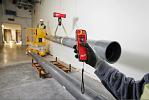Vice-President
- FMA
- The Fabricator
- FABTECH
- Canadian Metalworking
Control your destiny
Keeping work in-house improves control of deliveries, margins
- By Ken Hurwitz
- September 5, 2016
This month I thought it would be a good idea to discuss some of the reasons that manufacturers invest in new equipment. Having done equipment financing for about six years, I have been fortunate enough to get a unique perspective on many of these actual investments and transactions.
There is no doubt that regardless of whether a manufacturer chooses to use its own working capital or money from its chosen financial institution, putting a new piece of equipment on the floor comes at a significant cost.
Most manufacturers invest in new equipment for one of the following reasons:
- They have landed a new contract from an existing customer and need the additional capacity to manufacture more product.
In many cases they are under pressure to get equipment on the floor and running because they need to get more parts out the door. Also, since it is an existing customer they have spent plenty of time developing, they don’t want to do anything that will negatively affect that relationship.
Even if manufacturers have landed business from a new customer, they are still under the same pressure to deliver product on time, all while making a good first impression.
- They have decided to put some new technology on the floor with the intent of making the same parts more efficiently.
Companies have to operate in an industry that is unregulated and fiercely competitive, where even a few cents per part could mean the difference between winning or losing hundreds of thousands or even millions of dollars’ worth of business.
At some point it is necessary to investm in new technology, because finding quicker and more efficient methods to make the same parts is the only way to remain truly competitive.
This could mean acquiring a new multiaxis CNC lathe that is capable of both turning and milling the part in one setup, as opposed to moving it between two separate machines.
Bring Work In-house
A trend I have seen from my client base this year, one in which the market has been relatively busy despite the turmoil out west with the falling price of oil and a weak Canadian dollar, is their choice to bring work back in-house as opposed to subcontracting it to another company.
I have a number of clients who looked at the amount of work they were sending out on a monthly basis and realized financing a new piece of equipment and keeping the work in-house would have a number of benefits.
One such company manufactures accessories for heavy-duty construction equipment. It has a well-laid-out shop with lots of space for growth, but had been subcontracting out its large parts because it lacked the proper equipment to handle them internally.
Unfortunately, the shop ran into difficulty getting parts machined locally that were within the necessary tolerances. Managers realized that if they put two new pieces of equipment on the floor and doing the work themselves -- even with the additional costs of tooling and material – out-of-tolerance parts would no longer be a problem and the monthly cost would still be below what they had been paying to subcontract the work.
Another company in the same situation was manufacturing its own product, specialized packing equipment, but for the most part was doing just design and assembly while subcontracting all the machining.
In addition to spending hundreds of thousands of dollars per year, the company had two additional issues: it wasn’t able to control its deliveries and its margins were small.
Fortunately, the unit next door became available and the company set up its own small machine shop with a vertical machining centre and a CNC lathe.
The costs associated with bringing the work in-house, which included hiring some new people since they had very little experience with machining, were still far less than the costs of sending the work elsewhere. Most important, however, the shop now had much more control over its production, and therefore deliveries, and it now had a new income stream, which ultimately showed up on the bottom line because its profit margin increased significantly.
Successful manufacturers that are financing equipment are looking at the transaction and making the business decision to analyze monthly cost and not just overall equipment cost. Once the thinking moves into this type of evaluation, the sticker shock of buying a new machine is either entirely disarmed or at least minimized significantly.
There is no doubt that keeping or bringing work in-house is the best and most profitable course of action for shops.
Ken Hurwitz is senior account manager, Blue Chip Leasing Corp., 416-614-5878, www.bluechipleasing.com.
subscribe now


Keep up to date with the latest news, events, and technology for all things metal from our pair of monthly magazines written specifically for Canadian manufacturers!
Start Your Free SubscriptionAbout the Author

Ken Hurwitz
41 Scarsdale Road Unit 5
Toronto, M3B2R2 Canada
416-499-2449
- Industry Events
ZEISS Quality Innovation Days 2024
- April 15 - 19, 2024
Tube 2024
- April 15 - 19, 2024
- Düsseldorf, Germany
CTMA Economic Uncertainty: Helping You Navigate Windsor Seminar
- April 30, 2024
- Windsor, ON Canada
MME Winnipeg
- April 30, 2024
- Winnipeg, ON Canada
CTMA Economic Uncertainty: Helping You Navigate Kitchener Seminar
- May 2, 2024
- Kitchener, ON Canada




















